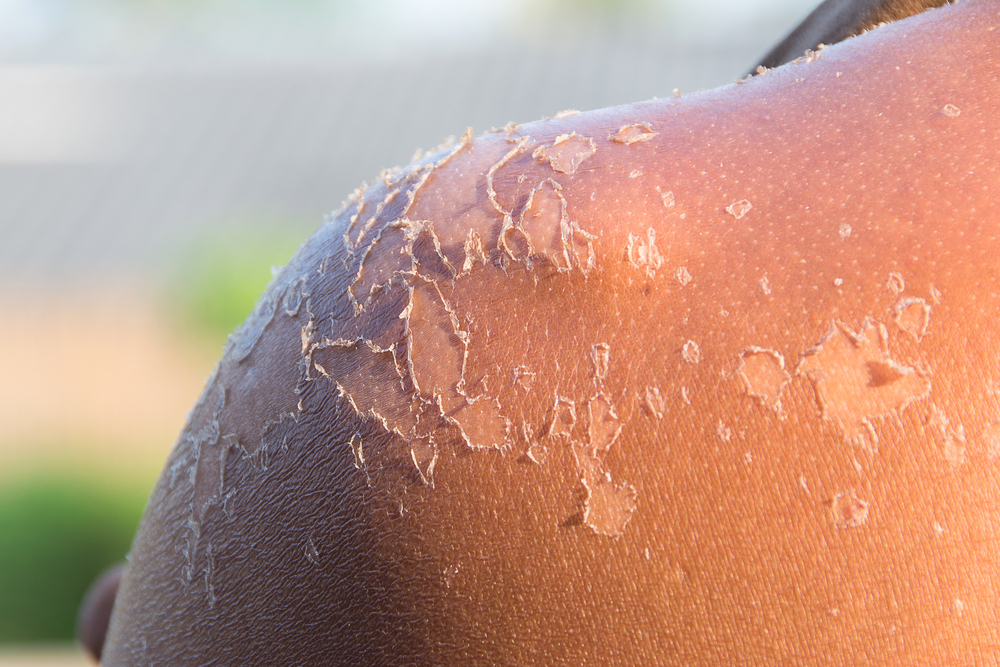Imagine: After a day out in the sun, you notice your skin feels a bit sore or has a reddish hue. A few days later, your sunburned skin starts to peel. A sunburn was bad enough—now this?
Peeling skin can be downright frustrating. You may be tempted to pick at it to get rid of it quicker, but understanding a few best practices is key to proper healing. If you want to know how to prevent your skin from peeling in the first place, read on to discover the ins and outs of post-sunburn peeling to stay ahead of it and treat it when it does happen.
Why Skin Peels from Sunburn
In some cases, a new and inconvenient sunburn symptom sets in as the redness subsides: peeling. But why does this happen? The Skin Cancer Foundation explains that peeling is the body's way of getting rid of damaged skin cells on the outermost layer of skin. You might think only severe sunburns cause lasting sun damage, but any sunburn—no matter how mild—is a sign of skin damage.
Peeling skin is a symptom of first-degree sunburn, so even a light or mild sunburn can peel. It usually happens a few days into a sunburn. Peeling skin is a telltale sign you're in the final stretch of healing, but you're not out of the woods just yet.
How to Prevent Your Skin from Peeling
The best way to prevent sunburn-related skin peeling is to protect your skin from the sun, which greatly reduces the risk of sunburns and long-lasting skin damage. The American Academy of Dermatology (AAD) suggests you use a broad-spectrum, water-resistant sunscreen with SPF 30 or higher. The AAD also recommends the following key strategies for sunburn prevention:
- Seek shade when spending time outdoors, especially during peak sun hours between 10 a.m. and 4 p.m.
- Wear clothes and accessories that offer protection from the sun, like long-sleeve shirts, wide-brimmed hats, and sunglasses.
- Reapply sunscreen every two hours or more often if swimming or sweating.
If you notice a sunburn forming, start sunburn treatments as soon as possible to help get ahead of peeling. Moisturizing a sunburn provides relief and soothes damaged skin, which may help minimize skin peeling.
Using Sunscreen beyond Beach Days
One of the best things you can do for your skin is to get into the habit of wearing sunscreen daily—not just during tropical vacations and trips to the beach. The sun's ultraviolet (UV) rays can penetrate your skin even when it's cloudy or snowing, so sunscreen should be part of your skin care routine 365 days a year. A sunscreen like EltaMD UV Sport Broad-Spectrum SPF 50 meets (and exceeds) the AAD's recommendations for adequate sunscreen.
Sunburn Self-Care: What to Do If You Have Peeling Skin
When a sunburn sets in, it's time to start some sunburn self-care. Taking cool showers, drinking lots of water, and preventing additional sun exposure can help treat sunburns. Other sunburn remedies include applying aloe vera, colloidal oatmeal, cool milk, and honey to your skin in the form of a bath or compress.
When you get to the peeling stage of a sunburn, keep it moisturized. This helps restore hydration, which is essential to supporting a healthy skin barrier. Moisturizing a sunburn with the right ingredients can help get your skin back on track as quickly as possible. For example, EltaMD Barrier Renewal Complex moisturizes the skin to restore healthy skin barrier function and improves dry, damaged skin within 24 hours. In addition to using a moisturizer, keep a humidifier nearby while you sleep and hang out around the house.
Guarding Your Skin Health
Exfoliating sunburned, peeling skin won't speed up the healing process. The Skin Cancer Foundation recommends letting the dead skin slough away on its own rather than picking at it or using an exfoliant. While you're healing, avoid any additional sun exposure as well. Freshly sunburned skin is fragile, and any unprotected sun exposure can delay your healing process. If you have to go outside, keep your skin covered with clothes, sunscreen, and shade.
Be patient with your skin and take special care. Before you know it, you'll be back to a healthy, smooth complexion that glows from the inside out.
